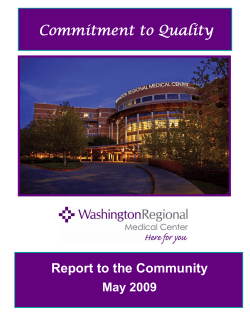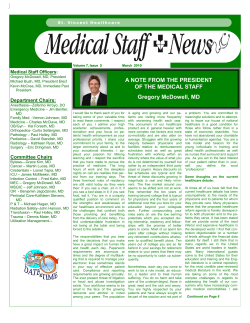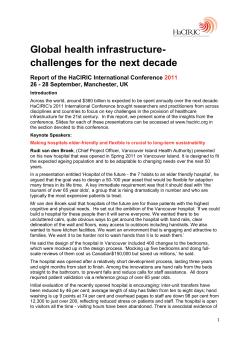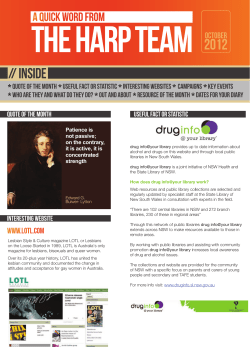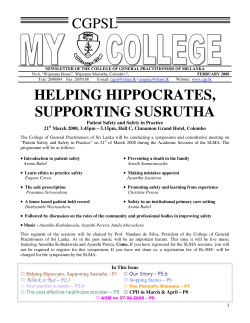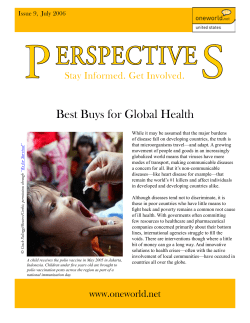
12 20 REPORT TO THE COMMUNITY
Please scan the QR Code for more information on the stories related to this report. uwmedicine.org 2012 CHRIS MARSHALL’S STORY REPORT TO THE COMMUNITY In February 2012, Christopher Marshall of Wasilla, Alaska, received an artificial heart at UW Medical Center. When he was admitted to the hospital, his heart was performing barely well enough to keep him alive. Most people who receive an artificial heart while waiting for a heart transplant must remain hospitalized. Because UW Medical Center is a regional leader in clinical trials, Marshall, an avid hiker, was able to leave the hospital with an implanted artificial heart and portable battery pack, and walk more than 600 miles in the seven months between implant and transplant. After a successful heart transplant in September 2012, he continued his explorations of the Seattle area on foot and is now back home in Alaska. uwmedicine.org 1 Accountable Care, Personal Wellness A DEMANDING CAREER. A NEIGHBORHOOD CLINIC. A DANCER ON HER TOES. Dear Colleagues, UW Medicine’s faculty, staff, students and trainees thrive on challenges. It is how we accomplish our mission to improve the health of the public. 2 3 4 5 6 A CALLING. A TERRIBLE PAIN. A REAL HERO. A LIFE IN TURMOIL. A DEDICATED TEAM. A HAPPY MOM-TO-BE. A RUNNER. A HURDLE. AN UNEXPECTED COACH. In September 2012, the Institute of Medicine issued a new challenge to healthcare organizations when it published Best Care at Lower Cost: The Path to Continuously Learning Health Care in America. This national call to action describes the American healthcare system as being “too complex and costly to continue business as usual.” It also holds all healthcare organizations and health professionals to being accountable for providing healthcare that is “consistently reliable and that constantly, systematically and seamlessly improves.” I am pleased to say that UW Medicine is ahead of the curve in meeting this national challenge. Our strategic plan focuses on reducing costs by optimizing access to primary and preventive care while providing basic and advanced services from the best qualified health professionals in the most appropriate UW Medicine settings. We are improving healthcare locally and globally. In fields ranging from genomics and biochemistry to pharmacology and ophthalmology, our researchers are advancing medical knowledge and establishing the building blocks for new treatments. At the UW School of Medicine, a new curriculum for medical students is being developed that will keep pace with today’s rapidly changing knowledge and technologies. The new curriculum will emphasize active learning by our students in small groups and at patients’ bedsides. Beginning in fall 2013, some of our medical students will have the option of completing their first two years of training at WWAMI Spokane as part of a pilot project to help meet regional needs for medical education. In support of our mission to improve the health of the public, we recognize the importance of personal wellness. As you can see from a recent photo, a morning workout on the Montlake Cut is one of my favorite health breaks. UW Medicine works to maximize wellness through preventive care and by helping people make incremental and individualized choices for personal health. I am deeply grateful to UW Medicine’s 25,000 faculty, staff, students and trainees for their remarkable and life-improving achievements. By delivering top-quality, safe, efficient and cost-effective healthcare, UW Medicine is a national leader for “best care at lower cost.” 7 A CANCELED SHOW. A DEADLY VIRUS. A SECOND CHANCE. A STRONG WOMAN. A WEAKENED HEART. A BOLD PLAN. uwmedicine.org/stories County, governed by a county-appointed Board of Trustees, and managed by UW Medicine. It is the region’s only Level I adult and pediatric trauma and burn center. Harborview also provides specialized services for vascular, orthopedics, neurosciences, ophthalmology, behavioral health, HIV/AIDS and complex critical care. . UW Medical Center provides highly specialized tertiary and quaternary care for cardiac care, cancer care, obstetrical care (including high-risk neonatal intensive care), sports, spine and orthopedics care, oncology, bone marrow and stem cell transplantation, and solid organ transplantation. People travel from across the Pacific Northwest and beyond for these and other services. Northwest Hospital & Medical Center is an acute care community hospital located in North Seattle. It attracts patients for primary and specialized care, including cardiac care, cardiology, cardiac surgery and rehabilitation, cancer treatment, labor and delivery, neurosciences, and community wellness programs. Valley Medical Center is an acute care community hospital and clinic network located in Renton. The oldest and largest public district community hospital system in Washington, Valley Medical Center serves more than 600,000 residents in Southeast King County. UW Neighborhood Clinics is a network of nine Paul G. Ramsey, M.D. 8 UW Medicine is the most comprehensive integrated health system for residents of Washington, Wyoming, Alaska, Montana and Idaho (the WWAMI region). Harborview Medical Center is owned by King A DOCTOR. A PROMISE. AN IRON HEART. A JUDGE. A MENTOR. A REPRIEVE FROM PAIN. UW Medicine: Patients Are First CEO, UW Medicine Executive Vice President for Medical Affairs and Dean of the School of Medicine, University of Washington primary care clinics located throughout the Puget Sound region. The clinics provide a wide spectrum of primary care and secondary care services, from pediatrics to geriatrics, using the medical home model. UW Physicians is the practice plan that employs approximately 1,800 UW physicians and health professionals who care for patients at UW Medicine and throughout the WWAMI region. The UW School of Medicine has been rated as one of the top three medical schools in the world with 30 clinical and basic science departments. Its researchers and teachers make life-improving discoveries while training medical students, residents, fellows and allied health professionals to care for future generations of patients. Airlift Northwest provides medical treatment and transport for critically ill and injured adults and children in the WWAMI region from its bases in Seattle, Bellingham, Arlington, Olympia and Yakima, Wash., and Juneau, Alaska. Since 1982, Airlift Northwest has provided life-saving care for more than 90,000 patients. Patients Are First In response to the Affordable Care Act and a desire to rapidly improve healthcare in the United States, healthcare organizations across the country are becoming Accountable Care Organizations. At UW Medicine, this transformational work is called Patients Are First. UW Medicine is building a culture of service excellence based on placing the needs of patients first. We are focusing on the entire patient experience, including access to care, quality, safety, and overall satisfaction. Our pillar goals provide system-wide performance targets for patient satisfaction, quality and safety, physician and employee satisfaction and fiscal responsibility. High-Quality Patient Care Brings Hope and Healing Brandon Hopper UW Medicine has adopted a multi-faceted approach to broaden clinical programs in primary and secondary care, improve quality, access and service, reduce costs, and lay the groundwork for becoming an Accountable Care Organization. In 2012, major accomplishments included: Brandon Hopper, a teen with a genetic heart condition, was hiking deep in the woods with two friends when he collapsed in cardiac arrest in May 2011. A friend began CPR and first responders continued chest compressions until a flight team from Airlift Northwest arrived. Taking turns, they continued administering CPR for 86 minutes, the second longest known survival record. Once stabilized, Hopper was flown to Harborview Medical Center. During his three weeks at the hospital, a defibrillator was implanted to monitor and correct abnormal heart rhythms. He now enjoys a full recovery. Richard Bach UW Medicine launched a new Center of Excellence for Palliative Care that is working to ensure a consistent vision and compassionate experience for patients needing end-of-life care as well as for those living with serious medical problems. UW Medical Center and Harborview Medical Center were ranked the two top hospitals in the region by U.S. News & World Report. Harborview Medical Center was the only healthcare organization in Washington state to receive two Awards of Excellence from Qualis Health for demonstrating leadership and innovation in improving healthcare practices. UW Medical Center opened the Montlake Tower. This new hospital wing provides increased capacity for oncology and expanded Level III neonatal intensive care unit patients, as well as more space for diagnostic and interventional imaging technology. The UW Neighborhood Clinics expanded to nine clinics, with two new locations in Ravenna and Northgate. The Northgate and Kent/ Des Moines clinics also became training sites for resident physicians in UW’s family medicine and pediatric programs. Northwest Hospital & Medical Center added ©2009 Isaac Hernandez/MercuryPress.com Brandon Hopper meets with nurse Ann Kellogg, a member of the Airlift Northwest flight team that provided life-saving care on the ground and in the air after he went into cardiac arrest near Mount Rainier. and expanded four programs: Orthopedic Joint Replacement Care Clinic, UW Medicine Hernia Center, UW Medicine Midwifery Service, and UWMC Multiple Sclerosis Center. Richard Bach, author of Jonathan Livingston Seagull, was badly hurt when his small plane crashed on San Juan Island, Wash., in August 2012. After being transported by Airlift Northwest to Harborview Medical Center, Bach was in a coma for more than a week and required intensive care for brain, chest and spine injuries. During his recovery, he completed the previously unpublished fourth part of his famous book. Valley Medical Center offered immensely With his family, Bach has established the "Gift of Wings" charitable fund in appreciation of the hope and healing that UW Medicine provides: www.supportuwmedicine.org/wings. Airlift Northwest observed its 30th anniversary and expanded services with turboprop planes based in Yakima, Wash., and Juneau, Alaska, to better serve local communities. popular community wellness programs such as GLOW for women, Pitter-Patter for expectant/new parents and GoldenCare for seniors. Innovation In Research UW Medicine is an exceptional home for research. In 2012, our researchers advanced scientific knowledge in all major aspects of medicine, as represented by the following studies. Clare McLean/UW Medicine Genome Operating Manual UW Medicine scientists were leaders in an international effort to unpack the mysteries of the human genome. Before Project ENCODE, 98 percent of the genome was not known or understood. In this large area of the genome, Project ENCODE found many switches that turn sections of DNA on and off. These switches determine if and when parts of the genetic code are read inside cells, and influence how a baby forms, the way different cells do their jobs and why we age. DNA-control failures underlie many diseases, including cancer. Limitless possibilities are opened by this profound new understanding. KIDNEY ON A CHIP Chambered devices, smaller than a credit card and lined with living cells, are being engineered to emulate the human kidney. The “organ on a chip” will assess the toxicity of new drugs. It might also check the effects of environmental pollutants and pathogens. The project is part of a national effort to develop similar devices for brain, lung and liver testing. PROTEINS BY DESIGN Imagine building a protein to accomplish a task, such as protecting against a flu virus. A protein’s architecture – its twists and crannies – determines its function. Its shape is predictable from its chain of amino acids, which fold in distinct patterns. This knowledge allows scientists to create useful molecular structures, from drugs to catalysts. The new Institute for Protein Design is advancing and pioneering this work. BLIND MICE SEE AGAIN In collaboration with scientists at the University of California, Berkeley, and the University of Munich, UW Medicine researchers found that the injection of a recently discovered substance temporarily and partially restored sight in blind mice. The chemical AAQ sensitizes damaged retina cells to light. Eye researchers hope an improved version of the compound might correct vision loss in older people. Dr. Gail Jarvik, UW medical geneticist, leads a study on applying DNA information to colon cancer treatment. DNA Sequencing In Patient Care Dr. John Stamatoyannopoulos leads worldwide efforts to understand the “operating manual” of the human genome. With colon cancer as an example, UW clinicians are examining the application of genome data in medical practice. For instance, how will a patient’s DNA reading inform treatment decisions? How will doctors explain ambiguous findings? Insights into personal, economic and other issues posed by clinical genome sequencing will guide use of the technology. Education For A Changing World The UW School of Medicine is recognized for excellence in training primary care physicians and for advancing medical knowledge through scientific research. To keep pace with new technologies and ways of learning, a major curriculum renewal for medical students is under way to integrate new knowledge, prepare students for lifelong learning with a focus on patient safety and quality, and connect early learning with clinical applications. TEACHING MORE AT THE PATIENT BEDSIDE UW medical students are gaining more knowledge sooner by getting out of the classroom to learn problem-solving at the patient bedside. Students tend to remember more when they see it firsthand with a patient, so educators are working to improve the integration of clinical experiences with classroom knowledge by providing patient interactions earlier in the curriculum. The result is an enhanced mentor-student teaching and learning experience in UW Medicine’s hospitals, clinics, clinical practices and teaching sites throughout the WWAMI region. WWAMI EXPANDS TO SPOKANE Clare McLean/UW Medicine TeamSTEPPS UW Medicine is one of five training sites in the United States for TeamSTEPPS (Team Strategies and Tools to Enhance Performance and Patient Safety). Developed by the U.S. Department of Defense’s Patient Safety Program in collaboration with the Agency for Healthcare Research and Quality, TeamSTEPPS is changing the culture of the medical profession by empowering every member of the care team to take ownership for clinical outcomes and patient safety. Clare McLean/UW Medicine The UW School of Medicine’s WWAMI program – a partnership with the states of Washington, Wyoming, Alaska, Montana and Idaho – has taken the next innovative step for regional medical education and is expanding its education program in Spokane. Beginning in fall 2013, some UW medical students will be able to complete their first two years of medical school training at Washington State University on the Spokane Riverpoint campus as part of a two-year pilot. It’s a major advance toward increasing the number of physicians outside of Western Washington. TELEMEDICINE Telemedicine is transforming healthcare delivery in remote areas through the evaluation and treatment of complex chronic conditions via video teleconferencing. Telemedicine trains community healthcare providers and allows primary care physicians to obtain timely consultations from a wide range of specialists. The program’s success is evident in improved patient access and chronic disease health outcomes. Lecture Halls Without Lectures Medicine, nursing and pharmacy students learn communication techniques and teamwork strategies during TeamSTEPPS training at the Institute for Simulation and Interprofessional Studies (ISIS). UW School of Medicine educators are moving rapidly toward teaching innovations like the “flipped classroom” to keep pace with student learning in today’s rapidly changing technological world. In the “flipped classroom,” students prepare online before class and then use class time to engage in problem-solving with faculty leaders and their fellow classmates. From online instruction and integrated courses, to video podcasts and hands-on exercises, today’s UW medical students are part of the new learning revolution. UW MEDICINE FAST FACTS patient services $325 million* Charity care provided by UW Medicine health system, * Includes $210 million provided by UW Medicine physicians and staff at Harborview Medical Center 1,405,541 Outpatient clinic visits 195,337 Emergency Department visits 64,234 Inpatient admissions 48,502 Operating room procedures 7,170 Infants delivered (Fiscal Year 2012) uw medicine represents Harborview Priority Patient Report Harborview Medical Center is owned by King County, governed by a county-appointed Board of Trustees, and managed by UW Medicine. The following report details care provided by UW Physicians and staff at Harborview to priority patient populations consistent with the mission of Harborview. Employees inpatient discharges 2,300 Physicians and faculty 4,600 FY 2012 FY 2011 Total Inpatient Discharges 1 19,123 19,758 WWAMI clinical faculty Mentally Ill 7,272 6,853 4,500 Students and trainees Trauma Service 5,257 5,699 $1 billion Research grant awards Substance Abuse 3,850 3,814 Burn Service 744 929 HIV/STD 380 363 Indigent 3 9,067 8,649 Non-English Speaking Poor 1,119 1,162 King County Jail Inmates 134 107 FY 2012 FY 2011 Total Outpatient Volumes 1 364,807 379,603 Mental Health Services 2 45,096 56,284 Non-Trauma Emergency Department 49,591 48,841 Substance Abuse 13,588 13,543 HIV/STD 15,393 16,341 Trauma Service 12,841 12,466 Sexual Assault Counseling (Visits) 5,129 4,991 Domestic Violence 409 394 Burn Clinic 2,121 1,851 Indigent 3 192,682 182,325 Non-English Speaking Poor 49,312 48,641 945 799 FY 2012 FY 2011 62,432 61,307 25,000 outpatient volumes King County Jail Inmates emergency department visits Emergency Department 1 Sum of patient type will not equal total discharges since some patients may group into multiple categories 2 Volume decreases between years reflect some changes in reporting methodology 3 Indigent population criteria Washington Administrative Code 246-453-040 Clare McLean/UW Medicine Box 358046 815 Mercer Street Seattle, WA 98109 Our Mission: To improve the health of the public by advancing medical knowledge, providing outstanding primary and specialty care to the people of the region, and preparing tomorrow’s physicians, scientists and other health professionals. Report Production UW Medicine Strategic Marketing & Communications, 206.543.3620 Project Manager: Steve Butler, Ph.D. Contributors: Brian Donohue, Leila Gray, Susan Gregg, Clare LaFond, Tina Mankowski, Clare McLean Photography: Rick Dahms (unless otherwise specified) Design: UpRoar Please scan the QR Code to learn more about the stories in this report. To find out more about UW Medicine, visit: uwmedicine.org
© Copyright 2025


